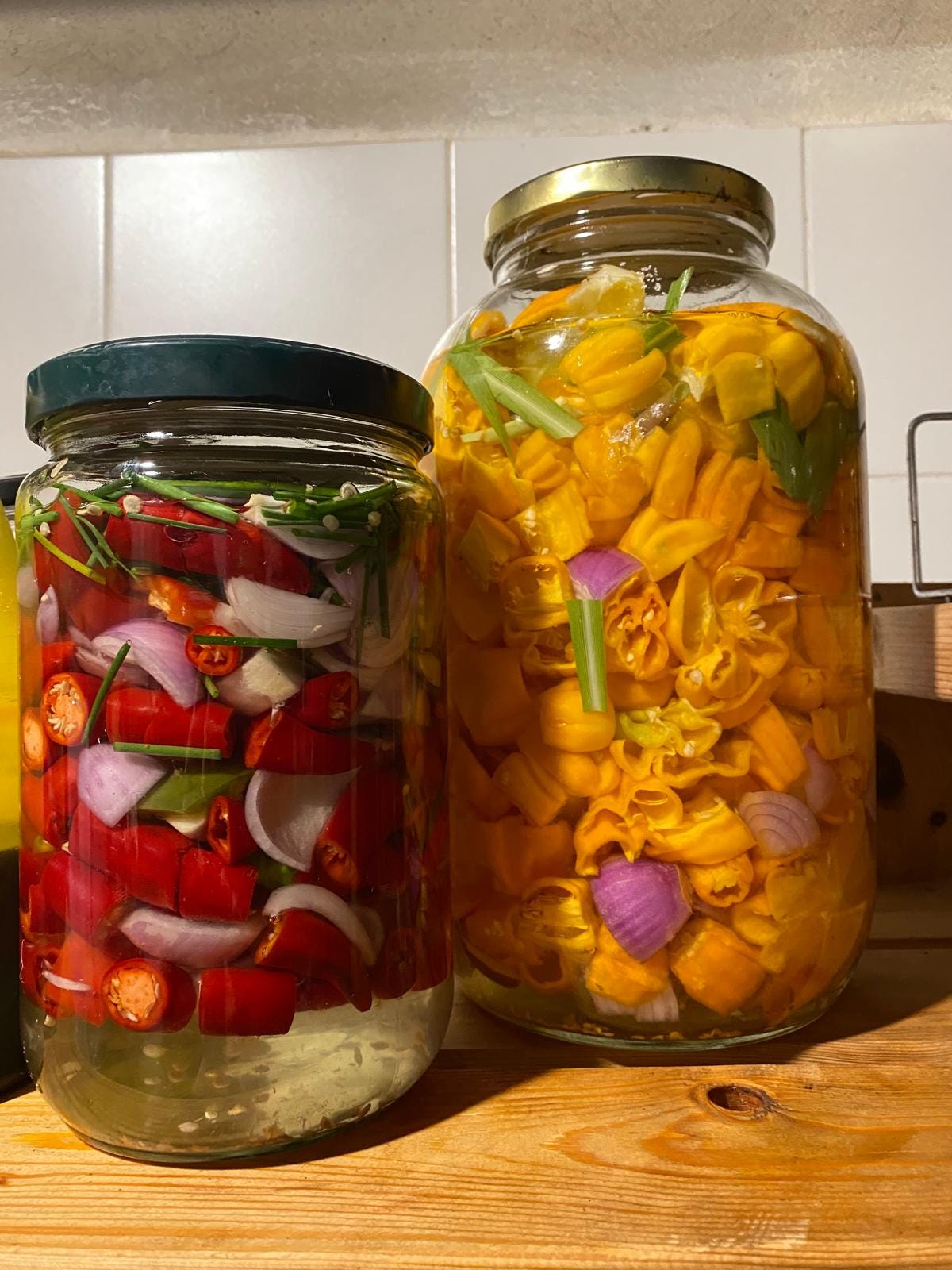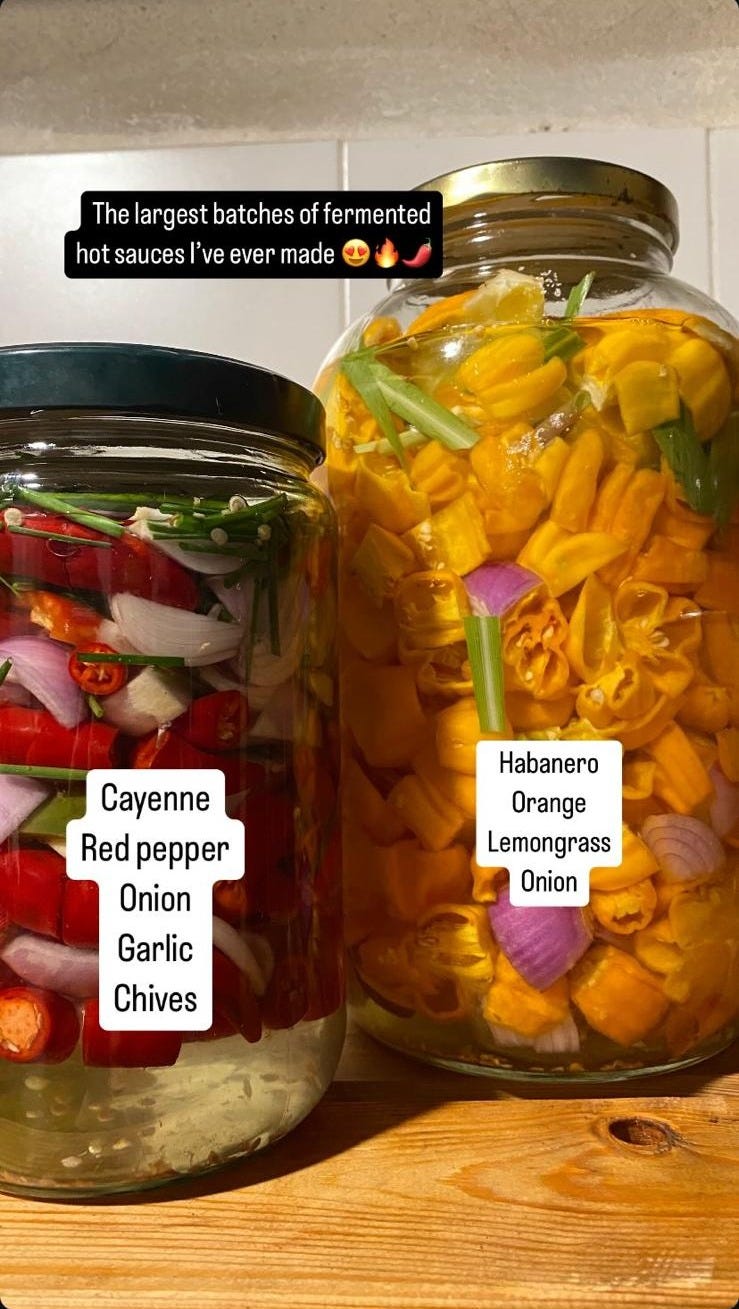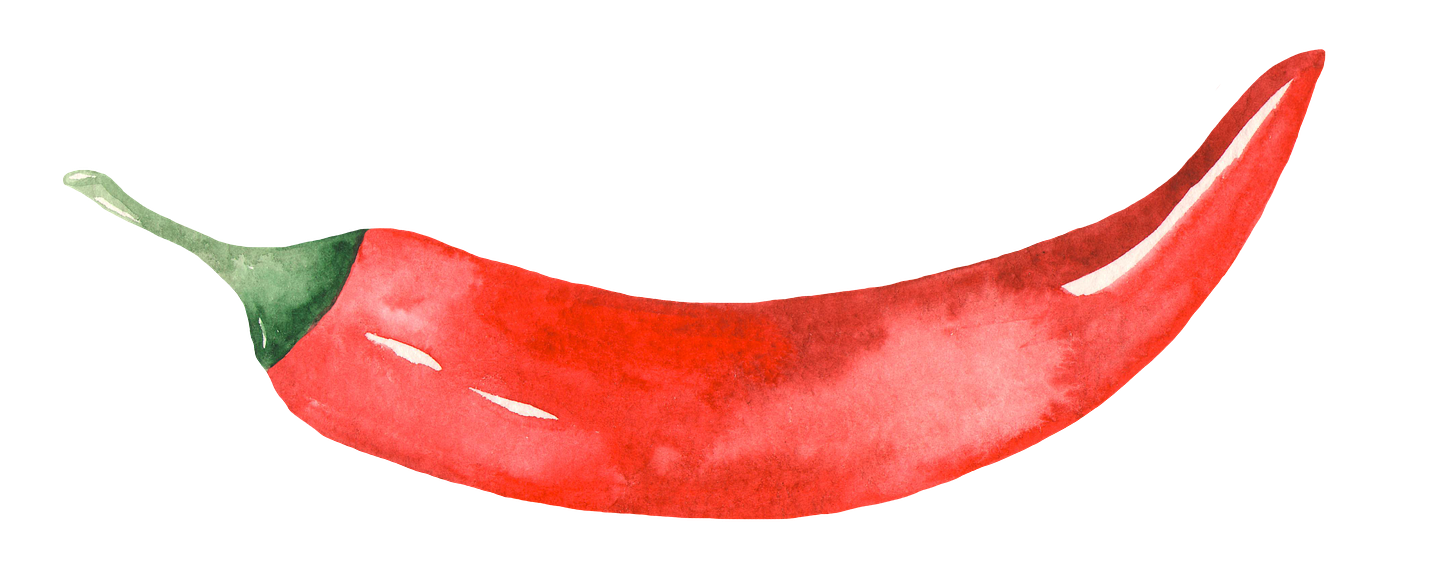Hello weavers!
I’m writing to you today with some fiery fingers - literally - as I finished the two big biggest batches of fermented hot sauces I’ve ever made.
I LOVE making fermented hot sauce - two of my favourite flavour profiles combined into one - extreme heat, and the acidic tang from our lactobacillus microbial friends (which is how this style of fermentation gets its name - lacto-fermentation). And the creative possibilities are endless.
I started making these hot sauces a few years ago, and the beauty of it is that you can use virtually any ingredients that are available to you. The recipe is actually super simple - get your ingredients together, chop and prepare them, and cover them with a salt brine made of 3-4% salt to water. This works out to about 2.5 tbsp of salt per litre of water.
Essentially this salty water creates an environment in which no bacteria or fungi can thrive except for the lactobacillus ones we are working to cultivate. These humble bacteria offer amazing benefits for us - a mutually beneficial relationship we’ve cultivated over millenia of our ancestors cultivating their growth and benefitting from their gifts - including the complex lactic acid flavours, longer and safer preservation, providing beneficial microorganisms to support a healthy gut microbiome, and even making our food more nutritious and bioavailable. It’s hard to imagine how our ancestors believed that anything other than magic was happening to their foods when they preserved them in these ways.
** be sure to use either pickling salt, sea salt, or kosher salt, not regular table salt or Himalayan salt, and use filtered/unchlorinated water. If your tap water has chlorine and you don’t use a water filter - I recommend getting a filter! - you can leave water standing in a bowl without a lid for 24 hours, and most of the chlorine will evaporate out.
Part One: Fermentation
Ingredients
Hot peppers
Spices / herbs
Salt (see note above)
Unchlorinated water
Materials
Sharp knife
Cutting board
Latex gloves (highly recommended)
Glass or ceramic fermentation vessel with a lid
Another bowl or jar for making salt brine
Stirring spoon
Fermentation weight / jar / Ziploc bag
Instructions
Gather peppers, or any vegetables for the lacto-ferment - this works for virtually all fruits and vegetables, and any desired herbs or spices.
Roughly chop everything and place it all into a large jar/fermenting vessel.
Make the salt brine in a separate container by stirring the salt until it’s completely dissolved.
(Almost fully) fill the fermenting vessel with the salt brine, covering the ingredients completely, leaving 1-3” at the top of the vessel.
Place a weight on top of the vegetables to keep them submerged under the brine - this can be a sanitized round stone, a specialty glass “fermentation weight”, another smaller jar, or even as simple as a Ziploc bag filled with salted water.
Secure the ferment with an airtight lid (ideally).
Leave the fermenting vessel in a warm place, and don’t forget to “burp” it - release the bubbles at least every couple of days.
The fermentation will begin within the first couple days - you’ll notice air bubbles that start rising from the bottom. The fermentation process will continue as long as you let it.
The longer the fermentation, the milder the hot sauce, and the more acidic/sour it becomes. Personally I prefer ridiculously hot hot sauce, so I like to cut off the fermentation process as soon as I regularly see air bubbles rising from the bottom, and when I notice the presence of kahm yeast. This is a yeast that makes the brine somewhat cloudy, and can even look like a layer of snow or ash has fallen on top of your veggies. This yeast is completely harmless - nothing to worry about at all. Fermentation time can be anywhere from just a few days in warm weather to a couple of weeks or more.
Part Two: Blending the Sauce
Materials
Large bowl
Strainer
Blender or immersion blender
Funnel
Silicone spatula (optional)
Hot sauce bottles
Labels
Instructions
Strain the fermented peppers through the strainer into a bowl to reserve the fermented brine.
Place all the vegetables into your blender, or a vessel for using your immersion blender. Add just a little of the brine - around a couple tablespoons to start.
Blend! Add more brine if necessary.
Use a funnel to transfer the sauce into bottles with narrow pouring spouts.
Be sure to label clearly, and store the hot sauce in the fridge to slow the fermentation process.
Don’t forget to wash your hands extremely well, and thoroughly clean all surfaces.
A few notes
The hot sauce will naturally mellow out over time as the fermentation process continues
If you notice a layer of white mould forming on the top of the ferment during the process, gently scrape it off, trying not to break it up into lots of little pieces. This kind of mould is not harmful, and it just means that the vegetables are being exposed to too much air and not the salty environment below the level of the brine. Try to keep everything fully submerged. This mould will not affect the flavour or safety of the finished product if you take it off early enough. If any black, blue, or grey mould is discovered, or if your ferment starts smelling REALLY funky and rank, sadly the brine was not salty enough, and the whole thing should really be composted/disposed of.
(Yes, ferments are really amazing for your compost, inoculating it with loads of great microbes)
If, like me, you believed that fermentation was “dangerous” and could make you sick if done incorrectly, I can assure you, it’s a very reliable process, and once you understand the basics, is actually so much safer than canning. As long as there is enough salt, and you’re working with very clean jars and kitchen equipment, this is a perfectly safe process, and I promise you’re going to get hooked. If you’re feeling uneasy, feel free to add a little more salt for your first few batches until you learn to trust it, and you can sanitize your vessels with strong vinegar, boiling water, or hydrogen peroxide (I have always just washed my fermentation vessels really well with soap and water and have never had issues).
The recipes
This time around, I made two large batches of hot sauce with some peppers from the gardens (here at Re-Green Ecoculture Centre in Seliana, Greece) - check out my Instagram video for the whole process:
Cayenne & Alliums - red cayenne pepper, red bell pepper, red onion, chives, and garlic
Citrus Habanero - habanero pepper, orange, red onion, and lemongrass
As a bonus, I also want to share another hot sauce I made last year, which was made with some peppers that our neighbour grew and gifted to us and some locally grown pink-flesh peaches!

You can get really creative with ingredients, but if you can’t handle the full-on heat, it’s best to add something to mellow out the flavour a little - this could be tomatillos, green tomatoes, bell peppers, carrots… let your imagination run wild - as you learn to team up with the wild ones who work this magic on your food for you.
Let me know if you do end up trying it out! I’d love to hear about it, and how you use the hot sauce.
I’m grateful to have gotten to partner with the wild microbes in a new (to me) land for this recipe. The fermentation process is familiar to how I do it at home, but the microbes and the ingredients here impart a unique flavour based on the growing environment - that unique terroir that somalliers speak of… the taste of the land. The taste of the life here.
“Are the acidifying bacteria in milk or the yeasts in grape juice our servants, or are we doing their bidding by creating the specialized environments in which they can proliferate so wildly? We must stop thinking in such hierarchical terms and recognize that we, like all creation, are participants in infinite interrelated biological feedback loops, simultaneously unfolding a vast multiplicity of interdependent evolutionary narratives.”
― Sandor Ellix Katz, The Art of Fermentation: An In-Depth Exploration of Essential Concepts and Processes from Around the World








Very cool!!🥰